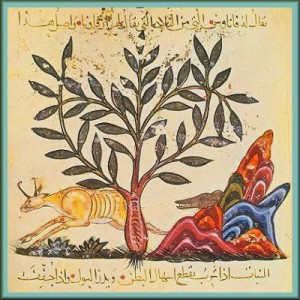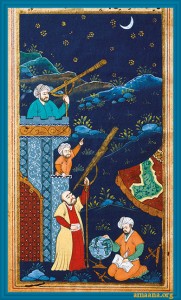 Medicine and Pharmacy under the Fatimids
Medicine and Pharmacy under the Fatimids
By Dr. Sami Hamarneh
The Fatimid rulers were Imams of the Shi‘a Isma‘ili Muslims and, as a result of the remarkable administration and economic stability of their government, they enjoyed great prosperity and prestige. Hospitals, libraries, mosques, schools and an observatory were established and generously endowed by them. Among them was the famous Al-Azhar University (970 CE) in Cairo and Dar al-‘Ilm (1005 CE). The teaching and practice of the healing arts advanced rapidly with the revival of other applied sciences and the arts. This appears more remarkable when one considers the vastness of the Fatimid Empire, which extended from the Atlantic shore of Morocco eastward to Egypt, Syria and Palestine, and down the Arabian Peninsula to Yemen. Under such a brilliant civilisation, technical and artistic activities were greatly advanced, learning was generously patronised, and health professions were very much honoured.
 More than any other era in Islam, a great part of this period’s literacy legacy in relation to natural history and medicine has been lost or destroyed. Historical evidences reveal continued and abundant productivity. For example, hospitals were highly regarded and well equipped throughout this period. In Al-Fustat there was a generously endowed hospital, Al-Bimaristan Al-‘Atiq, also known as the ‘Upper’ as compared to a later one, located downtown, called the ‘Lower’. It had adequate equipment and abundant supplies to fulfill its mission in serving the needs of poor and rich alike. With a well furnished library and two bath-halls for men and women, this hospital continued its services to the community’s health and educational needs for almost four centuries, up to the Mamluk period in the fourteenth century.
More than any other era in Islam, a great part of this period’s literacy legacy in relation to natural history and medicine has been lost or destroyed. Historical evidences reveal continued and abundant productivity. For example, hospitals were highly regarded and well equipped throughout this period. In Al-Fustat there was a generously endowed hospital, Al-Bimaristan Al-‘Atiq, also known as the ‘Upper’ as compared to a later one, located downtown, called the ‘Lower’. It had adequate equipment and abundant supplies to fulfill its mission in serving the needs of poor and rich alike. With a well furnished library and two bath-halls for men and women, this hospital continued its services to the community’s health and educational needs for almost four centuries, up to the Mamluk period in the fourteenth century.
The ‘Lower’ hospital was built in 957 CE. Its wards and kitchen were well stocked with plenty of food and drug supplies besides equipment needed for the apothecary shop. It also had spacious rooms for a library and lecture halls to promote teaching and useful medical knowledge. In these hospitals, while the sick were treated and healed, the health professionals were taught and advanced.
Medico-pharmaceutical contributions in North Africa under the Fatimids reached their highest expression in the works of Abu Ja‘far Ibn al-Jazzar (905- 984 CE) of Al-Qayrawan. His father Ibrahim, and his uncle Abu Bakr Muhammad, were both well known practitioners in the health field. Ibn al-Jazzar took the lead in promoting medical teaching and practice, and became the most eminent physician during the reign of Imam-caliph Al-Mu‘izz in North Africa.
Over 30 books on history, biography, geography, philosophy, literature and medico-pharmaceutical related topics are attributed to Ibn al-Jazzar, but many of them have been lost. Among those that survived is a medical compendium, Zad Al-Musafir Wa-Qut Al-Hadir in seven treatises.
In the foreword, Ibn al-Jazzar writes, “It contains a concise but complete presentation of what the estimable ancient sages (especially Hippocrates, Rufus, Ephesus and Galen) have written out of their wide knowledge regarding the pathology and treatment of diseases of each organ of the body from head to foot … In view of its comprehensive merits for all those engaged in the healing arts, this book is meant to serve as a teaching manual for the medical student, a thesaurus to the practitioner, and as a guide to the traveller to far away rural places (hence entitled Zad Al-Musafir), where scarcely a physician can be found.”
The book is divided into two parts, the first one contains the first four treatises in 86 chapters and discusses diseases of the head, such as hair and skin ailments, headaches, migraine, insomnia, cranitis and facial paralysis (Bell’s palsy); then eye, ear and mouth hygiene, common colds, thorax and cardiac ailments, tonsillitis, coughing, irregular heart movement, angina and finally diseases of the digestive system.
Part two contains the last three treatises in 70 chapters on diseases of the liver and spleen, including jaundice, kidney and bladder stones, urine retention, genital organs including atresia of the uterus, labour pains, gout and sciatica. It also includes a discourse on fevers including small-pox and measles, general skin irritations, burns, wounds, and their treatment and toxicology.
A home remedies text book, Tibb Al-Fuqara’ Wa’l-Masakin in 58 chapters is based entirely on earlier Greek and Arabic sources. It was intended for patients who needed medical treatment but could not afford expensive drugs and costly fees of the physicians. The text focused on the familiar and widely available materia medica for the preservation of good health and the cure of common diseases. The author felt an urgent need for its compilation after the publication of his previously mentioned Zad Al-Musafir in response to community needs. It treats such common ailments as head, ear, tooth and stomach aches and pains, coughing, asthma, colic and hoarseness – recommending well tried, useful and readily available remedies in a variety of pharmaceutical forms. In it he prescribes even sublingual tablets in use up to modern times.
The Siyasat Al-Sibyan Wa-Tadbirihim on paediatrics and care for mother and child’s health is in 22 easy-to-read chapters. In it the author discusses child health before and after birth and up to puberty, including the choice of the nurse, milk and supplemental feeding, cleanliness and natural growth. Interestingly, he focuses on the child’s habits and upbringing to preserve and promote good health. He explains that it is much easier to instil good healthy habits and the appreciation of useful knowledge in the lives of children than in adults. He emphasises the importance of the study of paediatrics among the health disciplines, and laments the fact that this topic has been “miserably neglected by the ancients so that no single independent text can be found. Moreover, known data are scattered in so many different compendiums that it is difficult to compile when needed.” Thus he “earnestly collected, condensed and discussed in one book all the available information just as one brings scattered pearls together to make out of them a beautiful crown or an elegant necklace.”
The Fatimid dynasty reached its zenith after moving the seat of administration from Tunisia to Cairo. Its Caliphs generously encouraged learning and a number of prominent physicians thrived during this era and made invaluable contributions to the development of modern science.
Source: Ilm, Vol. 9, No.2, pp 24-26 in 1985
Related
- Free Will in Ismaili Shi’ism
- The Origins of Shi’sm: A Consensus of Western Scholarship by Jonah Winters
- Ismaili Theology: The Prophetic Chain and the God Beyond Being by Wilferd Madelung
- Nasir al-din Tusi
- Ismaili Dai and Poet Al-Mu’ayyad
- Majalis-ul Muayyadiya – by Al Muayyad fid-din Shirazi
- Fourteen Proofs of the Necessity of lmamat — Kirmani
- Free Will in Ismaili Shi’ism and Free Will in Twelver Shi’ism
- Reincarnation or Companionship on High?
- Ismaili Heroes
- Nasir Khusraw Collection
- Qadi Numan’s Majalis
- Philosophical Significance of the Imam in Ismailism
- Beyond Polemics and Pluralism: The Universal Message of the Qur’an — Reza Shah-Kazemi
- Imam and Imamat — Allama Hunzai
- The Holy Quran in the Ginanic Literature – Rashida Noormohamed-Hunzai
- A Bridge Between Two Epochs — Aga Khan III, by Rashida Noormohamed Hunzai
- Music in Persian Mysticism — Henry Corbin
- Yaqub Sijistani Ismaili Theologian
- Philosophical Significance of the Imam in Ismailism